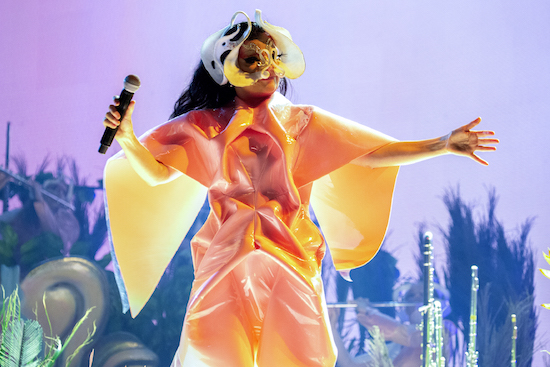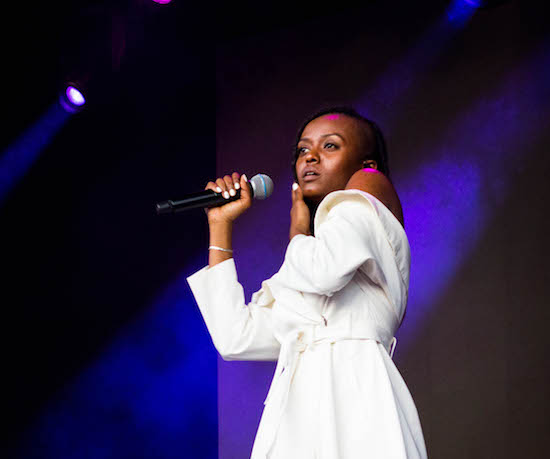Kelela photographed by Naomi Yates
The screens show a woman getting ready backstage, preparing to step out. A hush sails over the crowd. We are transported, distracted from the graceful and mighty photovoltaic sculpture to the left of the stage, just one of the sumptuous architectural offerings that fill the festival site. Art is, of course, central to Barcelona, and this artful transformation of the Parc Del Forum – tarmacked flats shrouded by sleek lines and tantalising views – never feels clinical or industrial. Rather, it is strong and graceful, reminding us of their power and delicacy. And so, to Kelela.
She emerges, dressed entirely in crisp white, turns to the side, strikes an abrupt pose, carefully lifts her head high, brings the mic to her lips and launches into ‘LMK’. Art and space are central to the LA artist’s practice, and as she performs with her backing singers (also in white), and her DJ (the excellent Loric) behind her, it’s clear this is not a mere drop-in festival performance.
Each move is considered, and the effect is commanding: this is art in motion. She does it without an abundance of backing visuals, dancers, or staging, but with a DJ who chops and screws tracks like ‘Take Me Apart’ into thrilling club mixes, then later, a stage set that bathes her in purple light for ‘Blue Light’. Her voice, at points, battles against being drowned in sound but no one seems to care (least of all the baby pink-haired guy next to me in floods of tears).
On ‘Frontline’ she slowly dips down to the ground, allowing a curtsy that reveals just a hint of her inner thigh – always in control, never giving away too much. Faux-stern poses punctuate each note as she syncs with her backing dancers, jerking her body and holding facial expressions back just before the basses drop and the crowd screams – then she lets her smile break, and she’s here again, teeth and glow and jubilance before turning around, taking a sip of water, and gaining composure again for a new piece.
“There’s this rule that you can’t do ballads at the festival – I say fuck that! So, here’s a really fucking sad song so you can get up on your fucking feelings.” This was the preamble before launching into ‘The Message’. As if to make her point about delectable disruption, she sings into a loop pedal, bewitching the track with a club injection. The lyrics are heartbreaking, but next to me people are forming circles to vogue in, throwing legs in the air and death-dropping in accordance with Kelela’s beat. “Can I get some flanger?” she asks the sound desk at one point. “I need some flanger!” Then she shows us just how far she’s come from the single that changed everything – those first sonic swells of dizzying, delectable pulsing claps of ‘Bank Head’.
Kelela is expert at exploiting the light and dark, exploring the rich and sparse elements at work – the richness of her vocal against the spacious backdrop. She understands keenly the power of restraint. When she finally, tentatively, delivers that “Let it go” line, we’re at the precipice of a cliff waiting for her to jump into a burst of powerful vocal runs. Instead, she employs control to draws us in, keeping us on the edge of tension. She offers a tantalising amount of herself. Art is best when it takes you on a ride, and Kelela deconstructs power and art on stage with grace – she makes you feel free as you watch her release herself, contort her face with each big note, as she makes her R&B do sonic acrobatics. Flicking her hair, she takes a bow after leaving a cloud of sex and power and tantalising energy in the air, after teaching our feelings out of us, forcing us to inhale with her, imploring us to use her art to help us exhale.

Björk photographed by Santiago Felipe
If Kelela’s artistic practice is about space and restraint, Björk is a sensory kaleidoscope which does the same thing – channeling power – in the completely opposite way. The Friday headliner, she performs on the main stage with a mission statement projected before she comes on: “Imagine a future, be in it.”
If it will take generations for Gaudi’s artistic vision to be realised at the Sagrada Familia, a few miles away, then Björk’s vision will take at least a lifetime, maybe several lifetimes – and each incarnation is as thrilling as the last. This project, an extension of last year’s Utopia album, is imagining just that. The stage is filled with flora and fauna, a garden of Eden with Björk at its centre dressed in orange and gold. conjuring the image of a flower with PVC petals draped over her and platforms that made her footsteps glide. In this city, the home of fantastical pioneers of surrealism and dada, she sings ‘Human Behaviour’ to a swaying crowd, in the night heat, and it is nothing short of rousing.
Choreographed flautists sway in perfect motion and she comes into focus – wearing a flower Chinese dragon-esque mask in gold – conjuring notes of a womb or a stamen. As she almost whispers ‘Hidden Place’ she demands space and her voice resonates through the quiet crowd. The visuals are spellbinding, with images of graceful spins and swirls of colours and shining orbs – a hallucinatory delight if you go in for that kind of thing, but even if your focus isn’t enhanced by class As the magic still lands in abundance. She implores you to let yourself sink into her utopia. Her previous VR ‘Biophilia’ project literally invited you into her mouth, and tonight she’s asking you to imagine something greater; she leads us through her garden to show us the possibilities, and we happily follow. Art can do that.


